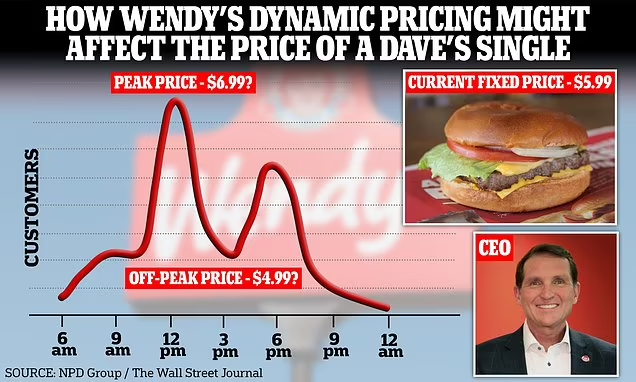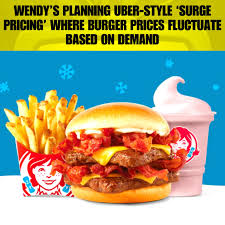In recent years, the availability of fast food has diminished, reflecting a broader trend of rising prices across industries. Gone are the days of grabbing multiple items from the dollar menu, even at popular chains like In-N-Out, once lauded for their wallet-friendly offerings. While fast food has always been a convenient option for those on the go, its availability has decreased as prices have continued to rise. Unfortunately, this trend shows no signs of abating, especially with the recent announcement of a major player in the fast food industry.
Wendy’s, the famous fast food chain, has revealed plans to introduce a surge pricing model similar to Uber’s dynamic pricing system. Under this new approach, menu prices will change throughout the day based on demand, which can lead to higher costs at peak meal times. The company’s CEO, Kirk Tanner, highlighted the implementation of sophisticated technology, including real-time price updates on digital menu boards, to support the initiative. While the specifics of the pricing changes remain undisclosed, the move signals a significant departure from traditional fixed-price models in the fast-food industry.
Everything is so expensive these days and unfortunately, fast food is no exception.
Long gone are the days of choosing a few items from the dollar menu at your favorite drive-thru.
Recently, even popular fast food restaurants like In-N-Out, which have been consistently praised for their reasonably priced menus, have raised their prices.
Yes, fast food is not the healthiest option, but
But in the past, it was an affordable and practical option to eat when you were pressed for time.
While this may still be a faster alternative, the drive-through will generally be almost as expensive as any other lunch spot.
Unfortunately, this trend doesn’t seem to be ending anytime soon – especially in light of a recent statement from a well-known fast food establishment.
New business plan…
It was announced this week that Wendy’s is going to try an “Uber-style” model of surge pricing at its restaurants.
Depending on demand, menu prices will change throughout the day.
This means that during lunch or dinner, the cost of a Dave’s burger or some nuggets will increase.
During a conference call with investors, Kirk Tanner, CEO of Wendy’s, unveiled the new strategy, revealing that the Ohio-based company will spend $20 million on sophisticated menu boards that will provide real-time price updates.
“As we continue to demonstrate the benefit of this technology in our company-operated restaurants, franchisees’ interest in digital dining boards should continue to drive sales and profit growth across the system,” Tanner said.
Tanner did not specify whether the base price would actually decrease during slower times, or how much a dynamic pricing approach might increase the price of a meal.
Wendy’s representatives declined to comment on the potential scope of the price changes.
“Dynamic pricing can allow Wendy’s to be competitive and flexible when it comes to pricing, incentivizing customers to visit and giving them the food they love at a great price,” a Wendy’s spokeswoman told The Post.
Items like Dave’s Single are already priced by location.
The publication claims that Dave’s Single in Newark, New Jersey costs $5.99, but the same burger costs $8.19 at Wendy’s in Times Square.
But industry experts have warned Wendy’s to brace for criticism if it tries to attract hungry diners with ever-changing prices.
Restaurant consultant Arlene Spiegel predicted, “They won’t fly and the guests will be very upset.” “You can’t surprise a guest by saying, ‘Your meal will cost an extra 50 cents or $1 today.’
Price Listo, a consumer transparency website, reports that Wendy’s is currently the most expensive fast-food restaurant in the US. This is because between 2022 and 2023 menu prices have increased by 35% due to inflation.
Contrary to all criticism, franchise owners say the goal of dynamic pricing is not to maximize profits but rather to help with scheduling and reduce the workload of kitchen staff at peak times.
“From a generational perspective, I think we see that as acceptable.”
Dog Haus franchise owner Faizan Khan said, “I think there’s a lot of wiggle room for consumers in terms of the price level they’ll accept,” during a recent Restaurant Finance and Development conference, as reported by Food & Wine.
Years of observing the success of the airline, hotel, and transportation industries have fueled the restaurant industry’s interest in dynamic pricing testing.
Experts predict that Burger King and McDonald’s, two rival restaurants, will be watching Wendy’s experiment closely.
According to restaurant expert Mark Kalinowski, “I think it’s only a matter of time before this becomes mainstream in the restaurant industry because it’s a way to generate more profits by being smarter about your pricing,” as reported to The Post.
In conclusion, the fast food pricing landscape is evolving, with Wendy’s announcing plans to introduce a surge pricing model reminiscent of Uber’s dynamic pricing system. The move marks a significant departure from the traditional fixed-price model that fast-food chains have long relied on. Because prices fluctuate based on demand, customers may find themselves paying more for their favorite Wendy’s meals during peak hours. While this approach aims to increase profitability and operational efficiency, it also raises concerns about transparency and customer satisfaction.
The implementation of surge pricing in the fast food industry reflects broader trends in consumer-facing businesses where dynamic pricing strategies are increasingly prevalent. Inspired by the success of industries such as airlines and hotels, restaurants are exploring new ways to optimize revenue and manage fluctuations in demand. However, the introduction of dynamic prices in fast food may encounter resistance from consumers accustomed to fixed menu prices.
Despite the potential problems, franchise owners and industry experts remain optimistic about the viability of dynamic pricing in fast food. He claims this approach could help streamline operations and improve customer service by encouraging off-peak visits. However, Wendy’s and other fast food chains will have to tread carefully to avoid alienating customers and damaging their brand reputation.
As the fast-food industry continues to adapt to changing consumer preferences and market dynamics, the success of Wendy’s price spike experiment will be closely watched by competitors and industry observers alike. Whether this innovative pricing strategy becomes widespread practice or remains a fringe experiment remains to be seen. Customer response will ultimately determine the long-term viability of price increases in the fast food sector.





